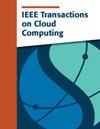FLAIR:数据中心间网络的快速低冗余故障恢复框架
IF 5.3
2区 计算机科学
Q1 COMPUTER SCIENCE, INFORMATION SYSTEMS
引用次数: 0
摘要
由于 5G 和物联网技术的快速发展,数据中心间(Inter-DC)网络正面临着前所未有的压力,需要实时复制大量地理分布广泛的用户数据。同时,随着跨数据中心网络规模的扩大,链路/节点故障也变得越来越频繁,对数据传输效率造成了负面影响。因此,链路故障恢复方法变得至关重要。许多著作对快速故障恢复进行了研究,但都没有考虑这种恢复方案的部署开销。在本文中,我们发现部署恢复策略的副作用和恢复传输的未来可用性也是快速恢复的关键。因此,我们提出了一种快速、低冗余的故障恢复框架--FLAIR,它由快速恢复策略 FRAVaR 和冗余去除算法 ROSE 组成。FRAVaR 通过最大限度地减少洗牌流量,充分考虑了部署开销。在此基础上,ROSE 通过删除不必要的路由更新,定期消除累积重路由冗余。在 4 个现实网络拓扑结构上的实验结果表明,与最先进的解决方案相比,FLAIR 成功地减少了高达 48.2% 的部署开销,从而降低了高达 70.2% 的恢复速度,提高了高达 36% 的网络利用率。本文章由计算机程序翻译,如有差异,请以英文原文为准。
FLAIR: A Fast and Low-Redundancy Failure Recovery Framework for Inter Data Center Network
Due to the fast developments of 5G and IoT technologies, Inter-Datacenter (Inter-DC) networks are facing unprecedented pressure to duplicate large volumes of geographically distributed user data in a real-time manner. Meanwhile, with the expansion of Inter-DC networks scale, link/node failures also become increasingly frequent, negatively affecting the data transmission efficiency. Therefore, link failure recovery methods become of utmost importance. Many works investigated fast failure recovery, yet none of them consider the deployment overhead of such recovery schemes. While in this article, we found that the side-effect of deploying recovery strategies and the future availability of the recovered transmissions are also crucial for fast recovery. So we propose a fast and low-redundancy failure recovery framework, FLAIR, which consists of a fast recovery strategy FRAVaR and a redundancy removal algorithm ROSE. FRAVaR takes full consideration of deployment overhead by minimizing shuffle traffic. On its base, ROSE regularly eliminates the cumulative rerouting redundancy by removing unnecessary routing updates. The experiment results on 4 realistic network topologies show that FLAIR successfully reduces up to 48.2% deployment overhead compared with the state-of-the-art solutions, and thus reduces up to 70.2% recovery speed and improves up to 36% network utilization.
求助全文
通过发布文献求助,成功后即可免费获取论文全文。
去求助
来源期刊

IEEE Transactions on Cloud Computing
Computer Science-Software
CiteScore
9.40
自引率
6.20%
发文量
167
期刊介绍:
The IEEE Transactions on Cloud Computing (TCC) is dedicated to the multidisciplinary field of cloud computing. It is committed to the publication of articles that present innovative research ideas, application results, and case studies in cloud computing, focusing on key technical issues related to theory, algorithms, systems, applications, and performance.
 求助内容:
求助内容: 应助结果提醒方式:
应助结果提醒方式:


